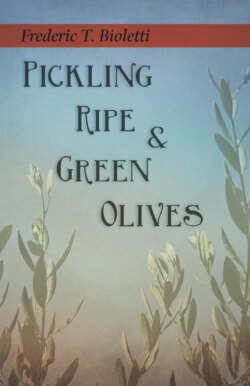Читать книгу Pickling Ripe and Green Olives - Frederic T. Bioletti - Страница 6
На сайте Литреса книга снята с продажи.
PRESERVING AND CANNING FOOD: JAMS, JELLIES AND PICKLES
ОглавлениеFood preservation has permeated every culture, at nearly every moment in history. To survive in an often hostile and confusing world, ancient man was forced to harness nature. In cold climates he froze foods on the ice, and in tropical areas, he dried them in the sun. Today, methods of preserving food commonly involve preventing the growth of bacteria, fungi (such as yeasts), and other micro-organisms, as well as retarding the oxidation of fats that cause rancidity. Many processes designed to conserve food will involve a number of different food preservation methods. Preserving fruit by turning it into jam, for example, involves boiling (to reduce the fruit’s moisture content and to kill bacteria, yeasts, etc.), sugaring (to prevent their re-growth) and sealing within an airtight jar (to prevent recontamination). Preservation with the use of either honey or sugar was well known to the earliest cultures, and in ancient Greece, fruits kept in honey were common fare. Quince, mixed with honey, semi-dried and then packed tightly into jars was a particular speciality. This method was taken, and improved upon by the Romans, who cooked the quince and honey - producing a solidified texture which kept for much longer. These techniques have remained popular into the modern age, and especially during the high-tide of imperialism, when trading between Europe, India and the Orient was at its peak. This fervour for trade had two fold consequences; the need to preserve a variety of foods - hence we see more ’pickling’, and the arrival of sugar cane in Europe. Preserving fruits, i.e. making jams and jellies became especially popular in Northern European countries, as without enough natural sunlight to dry food, this was a fail safe method to increase longevity. Jellies were actually most commonly used for savoury items; some foods, such as eels, naturally form a protein gel when cooked - and this dish became especially popular in the East End of London, where they were (and are) eaten with mashed potatoes. Pickling; the technique of preserving foods in vinegar (or other antimicrobial substances such as brine, alcohol or vegetable oil) also has a long history, again gaining precedence with the Romans, who made a concentrated fish pickle sauce called ’garum’. ’Ketchup’ was originally an oriental fish brine which travelled the spice route to Europe (some time during the sixteenth century), and eventually to America, where sugar was finally added to it. The increase in trade with the subcontinent also meant that spices became a common-place item in European kitchens, and they were widely used in pickles to create new and exciting recipes. Soon chutneys, relishes, piccalillis, mustards, and ketchups were routine condiments. Amusingly, Worcester sauce was discovered from a forgotten barrel of special relish in the basement of the Lea and Perrins Chemist shop! As is evident, the story of food preservation, and specifically the modern usages of jams, jellies and pickles encompasses far more than just culinary history. Ancient civilisations, nineteenth century colonialism and accidental discoveries all played a part in creating this staple of our modern diet.
